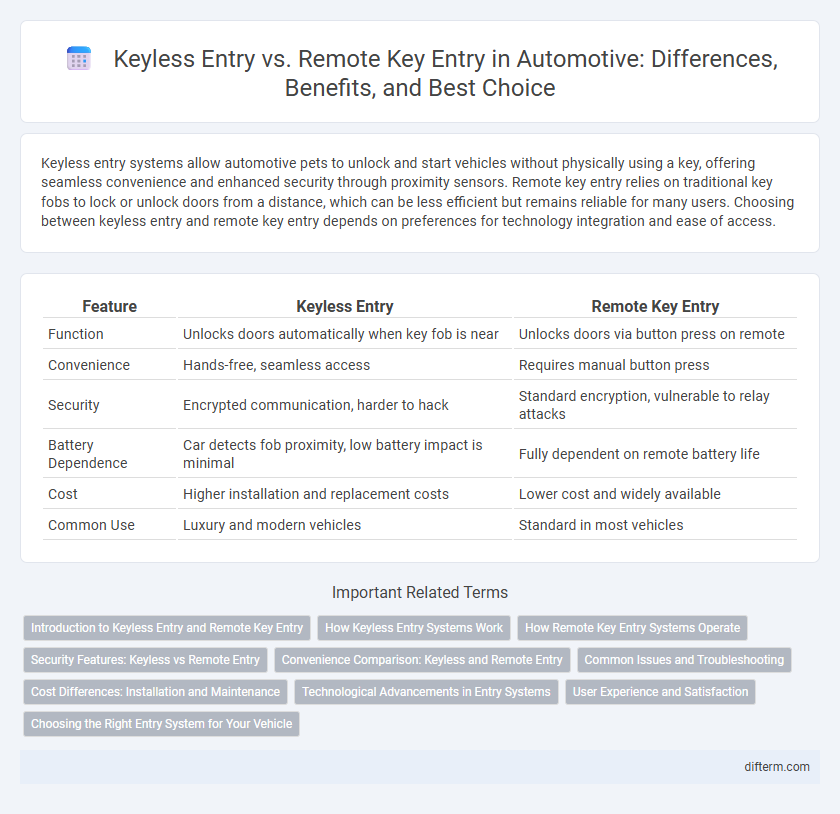Keyless entry systems allow automotive pets to unlock and start vehicles without physically using a key, offering seamless convenience and enhanced security through proximity sensors. Remote key entry relies on traditional key fobs to lock or unlock doors from a distance, which can be less efficient but remains reliable for many users. Choosing between keyless entry and remote key entry depends on preferences for technology integration and ease of access.
Table of Comparison
| Feature | Keyless Entry | Remote Key Entry |
|---|---|---|
| Function | Unlocks doors automatically when key fob is near | Unlocks doors via button press on remote |
| Convenience | Hands-free, seamless access | Requires manual button press |
| Security | Encrypted communication, harder to hack | Standard encryption, vulnerable to relay attacks |
| Battery Dependence | Car detects fob proximity, low battery impact is minimal | Fully dependent on remote battery life |
| Cost | Higher installation and replacement costs | Lower cost and widely available |
| Common Use | Luxury and modern vehicles | Standard in most vehicles |
Introduction to Keyless Entry and Remote Key Entry
Keyless entry systems allow drivers to unlock and start their vehicles without physically using a key, enhancing convenience and security through proximity sensors and push-button ignition. Remote key entry relies on a traditional key fob that transmits a radio signal to lock or unlock doors from a distance. Both technologies have revolutionized vehicle access, with keyless entry offering a hands-free experience and remote key entry providing remote control capabilities.
How Keyless Entry Systems Work
Keyless entry systems use radio frequency identification (RFID) technology to communicate between the vehicle and a small fob or smartphone app, allowing drivers to unlock and start their cars without physically inserting a key. These systems detect the proximity of the authorized device, enabling automatic door unlocking and engine ignition when the driver is near. Remote key entry, by comparison, requires pressing a button on the fob to send a signal to the vehicle, making keyless entry more seamless and convenient.
How Remote Key Entry Systems Operate
Remote key entry systems operate by transmitting encrypted radio signals from a key fob to the vehicle's receiver, allowing drivers to lock or unlock doors without physical contact. These systems use rolling codes to prevent signal interception and unauthorized access, enhancing vehicle security. Integration with the vehicle's onboard computer enables remote functions like trunk release and panic alarms, offering convenience beyond traditional keyless entry.
Security Features: Keyless vs Remote Entry
Keyless entry systems use encrypted radio signals and proximity sensors to unlock vehicles automatically when the key fob is nearby, enhancing convenience while maintaining robust security protocols against relay attacks. Remote key entry relies on fixed-range radio signals requiring manual button pressing, which can be more susceptible to hacking techniques like signal interception and replay attacks. Advanced keyless entry integrates rolling codes and two-factor authentication to reduce unauthorized access risks compared to traditional remote key entry systems.
Convenience Comparison: Keyless and Remote Entry
Keyless entry systems offer superior convenience by allowing drivers to unlock and start their vehicles without removing the key fob from their pocket or bag, enhancing seamless access. Remote key entry requires pressing a button on the fob to unlock the doors, which is less efficient in scenarios like carrying groceries or navigating inclement weather. Advanced keyless entry integrates proximity sensors and push-button ignition, significantly reducing physical interaction compared to traditional remote key entry methods.
Common Issues and Troubleshooting
Common issues with keyless entry systems include signal interference, dead key fob batteries, and software glitches that prevent door unlocking. Remote key entry problems often arise from worn-out buttons, weak transmitter signals, or receiver faults within the vehicle. Troubleshooting typically involves replacing batteries, reprogramming the key fob, checking for physical damage, and ensuring the vehicle's central locking system is functioning properly.
Cost Differences: Installation and Maintenance
Keyless entry systems typically incur higher installation costs than remote key entry due to advanced technology integration and compatibility with newer vehicle models. Maintenance expenses for keyless entry remain elevated, driven by complex electronic components and potential reprogramming needs, whereas remote key entry systems generally feature lower upkeep costs with simpler mechanisms. Consumers should evaluate total ownership expenses, including initial investment and ongoing service fees, to determine the most cost-effective option for vehicle access control.
Technological Advancements in Entry Systems
Keyless entry systems utilize wireless communication technology, such as RFID and Bluetooth Low Energy, to allow drivers to unlock and start their vehicles without physically using a key. Remote key entry relies on radio frequency signals for locking and unlocking doors from a distance, but lacks the proximity-based convenience and advanced security features found in keyless systems. Emerging technologies like smartphone integration and biometric authentication are driving innovation in entry systems, enhancing both security and user experience.
User Experience and Satisfaction
Keyless entry systems enhance user experience by allowing seamless access without fumbling for keys, offering convenience and reducing physical effort. Remote key entry provides a sense of security and control from a distance, enabling features such as remote locking, unlocking, and panic alarms that improve user satisfaction. Both technologies contribute to innovative automotive designs, yet keyless entry often ranks higher in customer preference due to its hands-free functionality and instantaneous access.
Choosing the Right Entry System for Your Vehicle
Keyless entry systems offer enhanced convenience by allowing drivers to unlock and start their vehicles without physically using a key, utilizing proximity sensors and push-button ignition. Remote key entry relies on a fob that sends a radio signal to lock or unlock doors, providing simple access but requiring manual interaction. When choosing between keyless entry and remote key entry, consider factors such as vehicle security features, ease of use, and compatibility with your car's make and model.
keyless entry vs remote key entry Infographic

 difterm.com
difterm.com